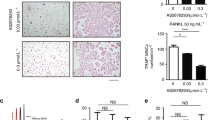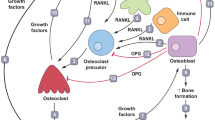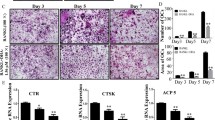Abstract
The aim of the study was to investigate inhibitory effects of the receptor tyrosine kinase (RTK) inhibitor SU11248 against CSF-1R and osteoclast (OC) formation. We developed an in vivo model of breast cancer metastasis to evaluate efficacy of SU11248 against tumor growth and tumor-induced osteolysis in bone. The in vitro effects of SU11248 on CSF-1R phosphorylation, OC formation and function were evaluated. Effects on 435/HAL-Luc tumor growth in bone were monitored by in vivo bioluminescence imaging (BLI), and inhibition of osteolysis was evaluated by measurement of serum pyridinoline (PYD) concentration and histology. Phosphorylation of the receptor for M-CSF (CSF-1R) expressed by NIH3T3 cells was inhibited by SU11248 with an IC50 of 50–100 nM, consistent with CSF-1R belonging to the class III split kinase domain RTK family. The early M-CSF-dependent phase of in vitro murine OC development and function were inhibited by SU11248 at 10–100 nM. In vivo inhibition of osteolysis was confirmed by significant lowering of serum PYD levels following SU11248 treatment of tumor-bearing mice (P=0.047). Using BLI, SU11248 treatment at 40 mg/kg/day for 21 days showed 64% inhibition of tumor growth in bone (P=0.006), and at 80 mg/kg/day showed 89% inhibition (P=0.001). Collectively, these data suggest that SU11248 may be an effective and tolerated therapy to inhibit growth of breast cancer bone metastases, with the additional advantage of inhibiting tumor-associated osteolysis.
Similar content being viewed by others
References
Coleman RE, Rubens RD. The clinical course of bone metastases from breast cancer. Br J Cancer 1987; 55: 61–6.
Perez EA. Current management of metastatic breast cancer. Semin Oncol 1999; 26: (4 Suppl 12): 1–10.
Clohisy DR, Perkins SL, Ramnaraine ML. Review of cellular mechanisms of tumor osteolysis. Clin Orthop 2000; 373: 104–14.
Kodama H, Yamasaki A, Nose M et al. Congenital osteoclast deficiency in osteopetrotic (op/op) mice is cured by injections of macrophage colony-stimulating factor. J ExpMed 1991; 173: 269–72.
Feng X, Takeshita S, Namba N et al. Tyrosines 559 and 807 in the cytoplasmic tail of the macrophage colony-stimulating factor receptor play distinct roles in osteoclast differentiation and function. Endocrinology 2002; 143: 4868–74.
Insogna KL, Sahni M, Grey AB et al. Colony-stimulating factor-1 induces cytoskeletal reorganization and c-src-dependent tyrosine phosphorylation of selected cellular proteins in rodent osteoclasts. J Clin Invest 1997; 100: 2476–85.
Mendel DB, Laird AD, Xin X et al. In vivo antitumor activity of SU11248, a novel tyrosine kinase inhibitor targeting vascular endothelial growth factor and platelet-derived growth factor receptors: Determination of pharmacokinetic /pharmacodynamic relationship. Clin Cancer Res 2003; 9: 327–37.
O'Farrell AM, Abrams TJ, Yuen HA et al. SU11248 is a novel FLT3 tyrosine kinase inhibitor with potent activity in vitro and in vivo. Blood 2003; 101: 3597–605.
Abrams T, Lee LB, Murray LJ et al. SU11248 inhibits kit and PDGFR beta in preclinical models of human small cell lung cancer. Mol Therapeutics 2003; 2: 471–8.
Laird AD, Cherrington JM. Small molecule tyrosine kinase inhibitors: Clinical development of anticancer agents. Expert Opin Invest Drugs 2003; 12: 51–64.
Schmidt CM, Settle SL, Keene JL et al. Characterization of spontaneous metastasis in an aggressive breast carcinoma model using flow cytometry. Clin Exp Metastasis 1999; 17: 537–44.
Harms JF, Welch DR. MDA-MB-435 human breast carcinoma metastasis to bone. Clin Exp Metastasis 2003; 20: 327–34.
Contag CH, Jenkins D and Contag PR et al. Use of reporter genes for optical measurements of neoplastic disease in vivo. Neoplasia 2000; 2: 41–52.
Wetterwald A, van der Pluijm G, Que et al. Optical imaging of Cancer Metastasis to Bone Marrow: A mouse model of minimal residual disease. Am J Pathol 2002; 160: 1143–53.
Armstrong SA, Kung AL, Mabon ME et al. Inhibition of FLT3 in MLL: Validation of a therapeutic target identified by gene expression based classification. Cancer Cell 2003; 3: 173–83.
Arguello F, Baggs RB, Frantz CN. A murine model of experimental metastasis to bone and bone marrow. Cancer Res 1988; 48: 6876–81.
Robins SP, Duncan A, Wilson N et al. Standardization of pyridinium crosslinks, pyridinoline and deoxypyridinoline, for use as biochemical markers of collagen degradation. Clin Chem 1996; 42: 1621–6.
Buckley KA, Fraser WD. Receptor activator for nuclear factor kappaB ligand and osteoprotegerin:regulators of bone physiology and immune responses/potential therapeutic agents and biochemical markers. Ann Clin Biochem 2002; 39: 551–6.
Zaidi M, Datta HK, Moonga BS et al. Evidence that the action of calcitonin on rat osteoclasts is mediated by two G proteins acting via separate post-receptor pathways. J Endocrinol 1990; 126: 473–81.
Hunt NC, Fujikawa Y, Sabokbar A et al. Cellular mechanisms of bone resorption in breast carcinoma. Br J Cancer 2001; 85: 78–84
Tamura H, Ishii S, Ikeda T et al. The relationship between urinary pyridinoline, deoxypyridinoline and bone metastasis in a rat breast cancer model. Breast Cancer 1999; 6: 23–8.
Smith IE. New drugs for breast cancer. Lancet 2002; 360: 790–2.
Mancino AT, Klimberg VS, Yamamoto M et al. Breast cancer increases osteoclastogenesis by secreting M-CSF and upregulating RANKL in stromal cells. J Surg Res 2001; 100: 18–24.
Flick MM, Sapi E, Kacinski BM. Hormonal regulation of the c-fms proto-oncogene in breast cancer cells is mediated by a composite glucocorticoid response element. J Cell Biochem 2002; 85: 10–23.
Coussens LM, Werb Z. Inflammatory Cells and cancer: think different! J Exp Med 2001; 193: 23F.
Valkovic T, Dobrila F, Melato M et al. Correlation between vascular endothelial growth factor, angiogenesis, and tumor-associated macrophages in invasive ductal breast carcinoma. Virchows Arch 2002; 440: 583–8.
Leek RD, Harris AL. Tumor-associated macrophages in breast cancer. J Mammary Gland Biol Neoplasia 2002; 7: 177–89.
Lin EY, Nguyen AV, Russell RG et al. Colony-stimulating factor 1 promotes progression of mammary tumors to malignancy. J Exp Med 2001; 193: F23–6.
Kacinski BM, Scata KA, Carter D et al. FMS (CSF-1 receptor) and CSF-1 transcripts and protein are expressed by human breast carcinomas in vivo and in vitro. Oncogene 1991; 6: 941–52.
Flick MB, Sapi E, Perrotta PL et al. Recognition of activated CSF-1 receptor in breast carcinomas by a tyrosine 723 phosphospecific antibody. Oncogene 1997; 14: 2553–61.
Kacinski BM. CSF-1 and its receptor in ovarian, endometrial and breast cancer. Ann Med 1995; 27: 79–85.
Toy EP, Chambers JT, Kacinski BM et al. The activated macrophage colony-stimulating factor (CSF-1) receptor as a predictor of poor outcome in advanced epithelial ovarian carcinoma. Gynecol Oncol 2001; 80: 194–200.
Maher MG, Sapi E, Turner B et al. Prognostic significance of colonystimulating factor receptor expression in ipsilateral breast cancer recurrence. Clin Cancer Res 1998; 4: 1851–6.
Tang R, Beuvon F, Ojeda M et al. M-CSF (monocyte colony stimulating factor) and M-CSF receptor expression by breast tumour cells: M-CSF mediated recruitment of tumour infiltrating monocytes? J Cell Biochem 1992; 50: 350–6.
Kacinski BM. CSF-1 and its receptor in breast carcinomas and neoplasms of the female reproductive tract. Mol Reprod Dev 1997; 46: 71–4.
Yee LD, Liu L. The constitutive production of colony stimulating factor 1 by invasive human breast cancer cells. Anticancer Res 2000; 20: 4379–83.
McDermott RS, Deneux L, Mosseri V et al. Circulating macrophage colony stimulating factor as a marker of tumour progression. Eur Cytokine Netw 2002; 13: 121–27.
Pickering LM, Mansi JL. The role of bisphosphonates in breast cancer management: review article. Curr Med Res Opin 2002; 18: 284–95.
Author information
Authors and Affiliations
Corresponding author
Rights and permissions
About this article
Cite this article
Murray, L.J., Abrams, T.J., Long, K.R. et al. SU11248 inhibits tumor growth and CSF-1R-dependent osteolysis in an experimental breast cancer bone metastasis model. Clin Exp Metastasis 20, 757–766 (2003). https://doi.org/10.1023/B:CLIN.0000006873.65590.68
Issue Date:
DOI: https://doi.org/10.1023/B:CLIN.0000006873.65590.68




